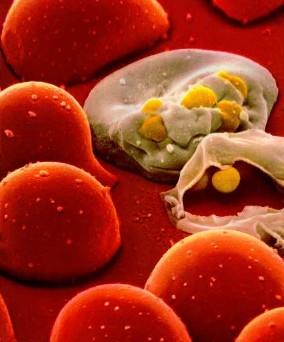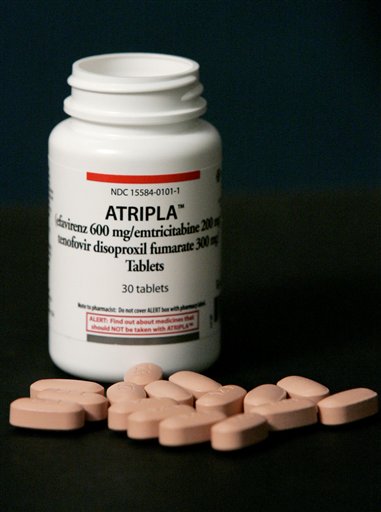
Infection with HIV occurs by the transfer of blood, semen, vaginal fluid, pre-ejaculate, or breast milk. Within these bodily fluids, HIV is present as both free virus particles and virus within infected immune cells. The four major routes of transmission are unprotected sexual intercourse, contaminated needles, breast milk, and transmission from an infected mother to her baby at birth. Screening of blood products for HIV has largely eliminated transmission through blood transfusions or infected blood products in the developed world.
HIV infection in humans is now pandemic. As of January 2006, the Joint United Nations Programme on HIV/AIDS (UNAIDS) and the World Health Organization (WHO) estimate that AIDS has killed more than 25 million people since it was first recognized on December 1, 1981, making it one of the most destructive pandemics in recorded history. It is estimated that about 0.6 percent of the world's population is infected with HIV. In 2005 alone, AIDS claimed an estimated 2.4–3.3 million lives, of which more than 570,000 were children. A third of these deaths are occurring in sub-Saharan Africa, retarding economic growth and increasing poverty. According to current estimates, HIV is set to infect 90 million people in Africa, resulting in a minimum estimate of 18 million orphans. Antiretroviral treatment reduces both the mortality and the morbidity of HIV infection, but routine access to antiretroviral medication is not available in all countries.

HIV primarily infects vital cells in the human immune system such as helper T cells (specifically CD4+ T cells), macrophages and dendrite cells. HIV infection leads to low levels of CD4+ T cells through three main mechanisms: firstly, direct viral killing of infected cells; secondly, increased rates of apoptosis in infected cells; and thirdly, killing of infected CD4+ T cells by CD8 cytotoxic lymphocytes that recognize infected cells. When CD4+ T cell numbers decline below a critical level, cell-mediated immunity is lost, and the body becomes progressively more susceptible to opportunistic infections.

Eventually most HIV-infected individuals develop AIDS (Acquired Immunodeficiency Syndrome). These individuals mostly die from opportunistic infections or malignancies associated with the progressive failure of the immune system. Without treatment, about 9 out of every 10 persons with HIV will progress to AIDS after 10-15 years. Many progresses much sooner. Treatment with anti-retroviral increases the life expectancy of people infected with HIV. Even after HIV has progressed to diagnosable AIDS, the average survival time with antiretroviral therapy (as of 2005) is estimated to be more than 5 years. Without antiretroviral therapy, death normally occurs within a year. It is hoped that current and future treatments may allow HIV-infected individuals to achieve a life expectancy approaching that of the general public.

TREATMENT
Human immunodeficiency virus (HIV) is a lentivirus (a member of the retrovirus family) that can lead to acquired immunodeficiency syndrome (AIDS), a condition in humans in which the immune system begins to fail, leading to life-threatening opportunistic infections. Previous names for the virus include human T-lymphotropic virus-III (HTLV-III), lymphadenopathy-associated virus (LAV), and AIDS-associated retrovirus (ARV).

Infection with HIV occurs by the transfer of blood, semen, vaginal fluid, pre-ejaculate, or breast milk. Within these bodily fluids, HIV is present as both free virus particles and virus within infected immune cells. The four major routes of transmission are unprotected sexual intercourse, contaminated needles, breast milk, and transmission from an infected mother to her baby at birth. Screening of blood products for HIV has largely eliminated transmission through blood transfusions or infected blood products in the developed world.

HIV infection in humans is now pandemic. As of January 2006, the Joint United Nations Programme on HIV/AIDS (UNAIDS) and the World Health Organization (WHO) estimate that AIDS has killed more than 25 million people since it was first recognized on December 1, 1981, making it one of the most destructive pandemics in recorded history. It is estimated that about 0.6 percent of the world's population is infected with HIV. In 2005 alone, AIDS claimed an estimated 2.4–3.3 million lives, of which more than 570,000 were children. A third of these deaths are occurring in sub-Saharan Africa, retarding economic growth and increasing poverty. According to current estimates, HIV is set to infect 90 million people in Africa, resulting in a minimum estimate of 18 million orphans. Antiretroviral treatment reduces both the mortality and the morbidity of HIV infection, but routine access to antiretroviral medication is not available in all countries.
HIV primarily infects vital cells in the human immune system such as helper T cells (specifically CD4+ T cells), macrophages and dendrite cells. HIV infection leads to low levels of CD4+ T cells through three main mechanisms: firstly, direct viral killing of infected cells; secondly, increased rates of apoptosis in infected cells; and thirdly, killing of infected CD4+ T cells by CD8 cytotoxic lymphocytes that recognize infected cells. When CD4+ T cell numbers decline below a critical level, cell-mediated immunity is lost, and the body becomes progressively more susceptible to opportunistic infections.
Eventually most HIV-infected individuals develop AIDS (Acquired Immunodeficiency Syndrome). These individuals mostly die from opportunistic infections or malignancies associated with the progressive failure of the immune system. Without treatment, about 9 out of every 10 persons with HIV will progress to AIDS after 10-15 years. Many progress much sooner. Treatment with anti-retroviral increases the life expectancy of people infected with HIV. Even after HIV has progressed to diagnosable AIDS, the average survival time with antiretroviral therapy (as of 2005) is estimated to be more than 5 years. Without antiretroviral therapy, death normally occurs within a year. It is hoped that current and future treatments may allow HIV-infected individuals to achieve a life expectancy approaching that of the general public.
MODES OF TRANSMISSION

• Sexual route. The majority of HIV infections are acquired through unprotected sexual relations. Sexual transmission can occur when infected sexual secretions of one partner come into contact with the genital, oral, or rectal mucous membranes of another.

• Blood or blood product route. This transmission route can account for infections in intravenous drug users, hemophiliacs and recipients of blood transfusions (though most transfusions are checked for HIV in the developed world) and blood products. It is also of concern for persons receiving medical care in regions where there is prevalent substandard hygiene in the use of injection equipment, such as the reuse of needles in Third World countries. HIV can also be spread through the sharing of needles. Health care workers such as nurses, laboratory workers, and doctors have also been infected, although this occurs more rarely. People who give and receive tattoos, piercings, and scarification procedures can also be at risk of infection.

• Mother-to-child transmission (MTCT). The transmission of the virus from the mother to the child can occur in utero during pregnancy and intrapartum at childbirth. In the absence of treatment, the transmission rate between the mother and child is around 25 percent.[18] However, where combination antiretroviral drug treatment and Cesarian section are available, this risk can be reduced to as low as one percent.[18] Breast feeding also presents a risk of infection for the baby.
HIV-2 is transmitted much less frequently by the MTCT and sexual route than HIV-1.
HIV has been found at low concentrations in the saliva, tears and urine of infected individuals, but there are no recorded cases of infection by these secretions and the potential risk of transmission is negligible. The use of physical barriers such as the latex condom is widely advocated to reduce the sexual transmission of HIV. Spermicide, when used alone or with vaginal contraceptives like a diaphragm, actually increases the male to female transmission rate due to inflammation of the vagina; it should not be considered a barrier to infection.
 Multiple Infections
Multiple InfectionsUnlike some other viruses, infection with HIV does not provide immunity against additional infections, particularly in the case of more genetically distant viruses. Both inter- and intra-clade multiple infections have been reported, and even associated with more rapid disease progression. Multiple infections are divided into two categories depending on the timing of the acquisition of the second strain. Coinfection refers to two strains that appear to have been acquired at the same time (or too close to distinguish). Reinfection (or superinfection) is infection with a second strain at a measurable time after the first. Both forms of dual infection have been reported for HIV in both acute and chronic infection around the world.
 Male Circumcision in Preventing Transmission
Male Circumcision in Preventing TransmissionA meta-analysis of 27 observational studies conducted prior to 1999 in sub-Saharan Africa indicated that male circumcision reduces the risk of HIV infection. However, a subsequent review indicated that the correlation between circumcision and HIV in these observational studies may have been due to confounding factors. Later trials, in which uncircumcised men were randomly assigned to be medically circumcised in sterile conditions and given counseling and other men were not circumcised, have been conducted in South Africa, Kenya and Uganda showing reductions in HIV transmission for heterosexual sex of 60 percent, 53 percent, and 51 percent respectively. As a result, a panel of experts convened by WHO and the UNAIDS Secretariat has "recommended that male circumcision now be recognized as an additional important intervention to reduce the risk of heterosexually acquired HIV infection in men. Research is clarifying whether there is a historical relationship between rates of male circumcision and rates of HIV in differing social and cultural contexts. Some South African medical experts have expressed concern that the repeated use of unsterilized blades in the ritual (not medical) circumcision of adolescent boys may be spreading HIV.



1 comment:
This is very powerful I ve been diagnosed with HIV 3years ago and I've become in denial at first for a year but later I accepted it and I'm living with depression so I struggle to keep my cd4 up bit I'm very healthy and I just checked my cd4 was 460 and they advising me to being medication but I'm not ready I wanna take them when at least it 350 I'm only 24years old I have a 6year old healthy boy negative and I've been very stressed lately I slept with a guy a month ago without a condom I always protect my self but this time he took the condom out without me noticing I became so scared knowing my status and I can't live with my self knowing that I infected one another person I told him that he should take p.e.p anti virus he said no he is clean there is no need unless I know I'm not clean I was so scared not ready to tell him following day took me to his doctor for me to come he is clean he tested in front of me n I fogged my result sent him someone else's result with my name I regret it and I'm scared don't know how to tell him I'm scared can't live with my self knowing that I did what I did after protecting all the guys I've been with for so long it;s about a day for me to tell him that I HIV positive that i came across testimony of a lady been cured of HIV from Dr James herbal mix, for me been so desperate I picked up interest and contacted Dr James and told him my problems and he asked me some few questions and then said I should send him money some so he can send me his powerful herbal mixed medicine and I did,2 days later he courier the herbal mixed medicine to me through DHL speed post the medicine got to me in 5 days time and I used it morning and night as he prescribed for me for 3 weeks and I was cured, I couldn't believe it because it was like a magic to me
then I was bold enough to meet the guy and told him that I had HIV but lucky am cured now, I recommended him to Dr James who cured him and he was cured too today we have been in a good relationship and we have 2years old son now and he is HIV negative Thanks to Dr James herbal mix if you are HIV positive or suffering from
CANCER
HERPES
DIABETES
HEPATITIS B
PID Virus. contact Dr James on
Email drjamesherbalmix@gmail.com
What's app +2348152855846
Post a Comment